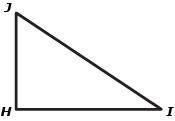
Mathematics, 17.11.2020 23:10 rajenkins79
In the figure below, JH = 3, HI = 4, and JI ≠ 5.
If we assume ∠H is a right angle, it follows that JI = 32 + 42−−−−−−−√ = 5. This contradicts the given statement that JI ≠ 5. What conclusion can be drawn from this contradiction?
∠H is a right angle
∠H is not a right angle
JI > 5
JI = 5


Answers: 3
Another question on Mathematics

Mathematics, 21.06.2019 19:40
What happens to the area as the sliders are adjusted? what do you think the formula for the area of a triangle is divided by 2?
Answers: 1

Mathematics, 21.06.2019 21:10
Which exponential function has an initial value of 2? f(x) = 2(3x) f(x) = 3(2x)
Answers: 1

Mathematics, 22.06.2019 00:00
Which expression is a perfect cube? a. x8 b. y24 c. m28 d. x64
Answers: 3

Mathematics, 22.06.2019 02:20
Find the area of the surface obtained by rotating the curve z=4e^2y from y = 0 to y =1 about the y-axis. the area is square units
Answers: 2
You know the right answer?
In the figure below, JH = 3, HI = 4, and JI ≠ 5.
If we assume ∠H is a right angle, it follows that...
Questions








Mathematics, 29.05.2020 21:03

English, 29.05.2020 21:03



Chemistry, 29.05.2020 21:03




Mathematics, 29.05.2020 21:04






